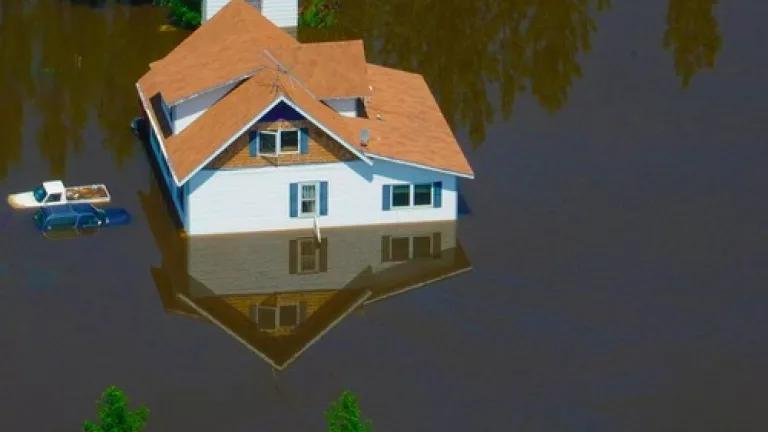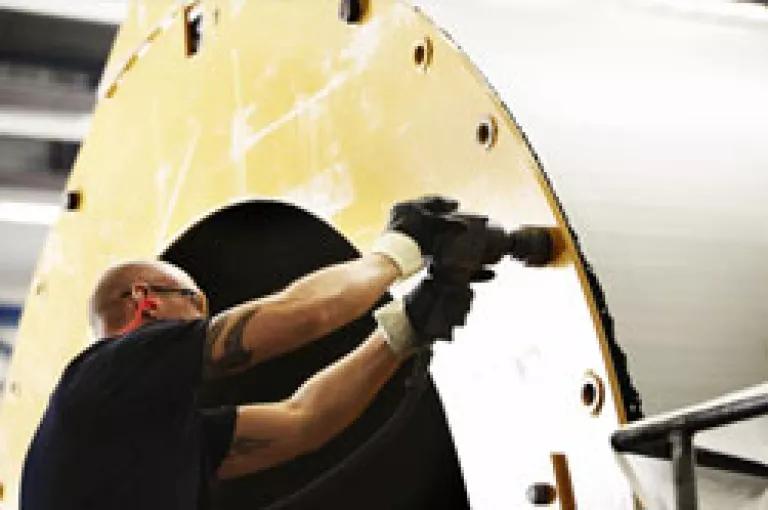
The latest report by the Nobel-winning Intergovernmental Panel on Climate Change sounds a piercing alarm about the dangers every nation faces from runaway climate change. Climate change, the IPCC scientists tell us, is already jeopardizing food supplies, water resources, even the stability of nations. And it will only get worse – unless we act fast to curb the pollution that is driving dangerous climate change, and unless we act fast to prepare for the impacts already in the pipeline.
Flooded home in Minot, North Dakota, 2011 (Creative Commons)
The IPCC report is a call to action. We can avoid the most destructive impacts of climate change if we act now. And we know what to do. Climate change solutions are already at work, maybe in your home, in your state, or your workplace. Maybe you’re driving a more fuel-efficient car, or walking or biking to work. Maybe you’re in the 25 percent—the quarter of the country living in states that are already reducing carbon pollution from power plants. Maybe, like me, you’ve put new insulation in your house, and are saving money on your utility bills.
We know these solutions work. Our task now is to scale them up, make them stronger--and do it fast.
The solution to tackling the country’s number one source of carbon emissions—power plants—is within reach. On June 2, the EPA, following a directive issued by President Obama, will announce a historic proposal to cut pollution from existing power plants, which are responsible for 40 percent of U.S. carbon emissions. Right now, there are no national limits on how much carbon power plants can pump into the atmosphere. They have a free pass to pollute.
This has to change. And again, we know how to do it. The details of the EPA’s proposal haven’t been revealed yet, but we do know the agency is looking closely at a blueprint developed by NRDC.
The Clean Air Act gives the EPA authority to limit carbon pollution. But for years, the thinking around Washington was that it would be too expensive, and perhaps not even effective, to tackle the problem this way. So NRDC set out to find a solution. We formulated an innovative, state-based plan that the EPA could use to cut power plant pollution. The plan is fair, flexible, makes real cuts in carbon—and when we ran the numbers, using the same analysis that utility companies do, we determined the plan is enormously cost-effective, too.
According to our latest analysis, the EPA could reduce carbon emissions from existing power plants up to 700 million tons each year by 2020—that’s as much as 31 percent, based on 2012 levels--using cleaner energy sources, more renewable energy, carbon capture and storage, and more energy efficiency.
The benefits for health and environment add up to anywhere from $28 to $63 billion each year by 2020, outweighing costs by at least 6:1 or as much as 15:1.
This isn’t a done deal. Much of the plan’s success will depend on the details proposed by the EPA in June. And we need to build support in the states to implement the plan, and ensure that local lawmakers are on board. That work has already begun.
The second big source of carbon pollution the Obama administration has tackled is transportation. By 2025, thanks to federal fuel efficiency standards, our cars will go twice as far on a gallon of gas. This is going to cut carbon pollution from new cars in half, while saving consumers $1.7 trillion at the pump. Automakers are on board with this plan because they know consumers want to cut fuel costs. They’ve already been working for years to meet California’s clean car standards, passed in 2002. Every year, we’re seeing more fuel-efficient cars on the market, and now the administration is working to come up with similar standards for heavy duty and other vehicles.
These efforts to limit pollution have positive ripple effects in the economy. More than 150,000 Americans go to work every day making parts for clean cars. More than 78,600 clean energy and clean transportation jobs were announced in 2013 alone. A couple of years ago in Cleveland, I met Lee Geisse, a member of United Steelworkers, who works as a greaser on a machine shop floor. She builds titanium hubs for wind turbines. Lee told me that even as her neighbors were losing jobs all around her in Ohio, she kept working all through the recession because her company had the foresight to get into the clean energy industry.

Manufacturing wind turbines
Yes, climate change is a reality, and we’re feeling its effects across the planet. But we’re also seeing the effects of solutions, and how they can make a profound difference in people’s lives. Right now, climate solutions are saving and creating jobs, reducing energy bills, and cleaning the air for millions of Americans. We’ve made a promising start, but we can’t afford to coast. We need to keep pushing ahead by setting strong limits on power plant pollution, building cleaner vehicles, and introducing more emissions-cutting solutions to ensure a secure and stable climate for the future.
